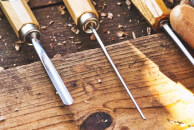Machine Safety Essentials in Woodwork


Woodwork Lesson Note for SS1 – First Term, Week 2
Topic: Machine Safety
Sub-Topics:
- Safety Precautions in the Use of Power Machines
- Safety Rules in Handling Portable Tools
Subject: Woodwork
Class: SS1
Term: First Term
Week: 2
Age: 14-16 years
Duration: 40 minutes
Behavioral Objectives
By the end of the lesson, students should be able to:
- Describe safe working habits when using woodworking machines.
- Identify safety precautions when operating power machines in the workshop.
- Demonstrate proper handling techniques for portable tools.
- Highlight the consequences of ignoring machine safety rules.
Keywords: Machines, Safety, Precautions, Power Tools, Portable Tools
Set Induction
The teacher narrates an incident where improper handling of a portable saw caused a severe injury. The teacher asks, “What could have been done to prevent this accident?”
Entry Behavior:
Students are already familiar with general workshop safety and the importance of observing safety rules.
Learning Resources and Materials:
- Samples of power machines (e.g., drills, saws).
- Portable tools like screwdrivers, hammers, and sanders.
- Charts illustrating machine safety precautions and potential hazards.
Building Background/Connection to Prior Knowledge:
Students discuss their experiences with handling basic tools and machines at home or in the school workshop.
Embedded Core Skills:
- Critical Thinking
- Practical Problem-Solving
- Communication
Reference Materials:
- Lagos State Scheme of Work
- Woodwork Textbooks and Safety Manuals
Content
1. Safety Precautions in the Use of Power Machines
Power machines like drills, saws, and planers make woodwork easier but can be dangerous if not handled properly.
Precautions include:
- Inspect machines for defects before use.
- Read and follow the manufacturer’s instructions.
- Ensure the machine is powered off before making adjustments.
- Keep loose clothing and jewelry away from moving parts.
- Always wear personal protective equipment (PPE), such as gloves and goggles.
- Use machines only for their intended purposes.
- Maintain a safe distance from moving parts or blades.
Examples:
- When using a table saw, ensure the safety guard is in place.
- When operating a drill, avoid forcing the bit into the material to prevent kickback.
2. Safety Rules in Handling Portable Tools
Portable tools include hammers, screwdrivers, and power sanders. Though smaller, they require careful handling.
Rules include:
- Always inspect portable tools for damage before use.
- Hold tools firmly and use both hands if necessary for stability.
- Avoid using tools with loose or broken parts.
- Store tools in their designated areas after use.
- Use the correct tool for the job to avoid damage to tools or materials.
- Never carry sharp tools in your pocket; use a toolbox.
Examples:
- Use the right screwdriver size to avoid stripping screws.
- Ensure sandpaper is securely attached to a sander before use.
Objective Questions
- Machine safety involves observing __________.
a) carelessness
b) precautions
c) speed
d) negligence - Before using a machine, always __________.
a) turn it on immediately
b) inspect it for defects
c) avoid reading instructions
d) force it to work - PPE stands for __________.
a) Personal Protective Equipment
b) Public Power Elements
c) Portable Protective Elements
d) Practical Personal Equipment - The safety guard on a table saw is used to __________.
a) make cutting faster
b) protect the operator from injuries
c) reduce electricity consumption
d) improve the saw’s speed - Portable tools should be stored __________.
a) on the floor
b) in a toolbox
c) under a machine
d) anywhere in the workshop - Loose clothing around machines can cause __________.
a) comfort
b) accidents
c) safety
d) cleanliness - When using a drill, avoid __________ the bit into the material.
a) forcing
b) aligning
c) cleaning
d) securing - Portable tools with loose or broken parts should be __________.
a) ignored
b) repaired or replaced
c) used carefully
d) hidden - Sandpaper should be __________ before using a sander.
a) wet
b) loosely attached
c) securely attached
d) folded - Machines should always be powered off when __________.
a) operating
b) making adjustments
c) cleaning the workshop
d) storing materials - Tools should be used for __________.
a) any purpose
b) the intended purpose only
c) fun activities
d) decoration - Carrying sharp tools in your pocket is __________.
a) acceptable
b) dangerous
c) recommended
d) optional - Kickback during drilling occurs when __________.
a) forcing the bit into material
b) using both hands
c) reading instructions
d) wearing gloves - A damaged power machine should be __________.
a) reported and repaired
b) ignored
c) used cautiously
d) hidden - The main goal of machine safety is to __________.
a) increase accidents
b) ensure efficiency and prevent injuries
c) improve workshop design
d) reduce productivity
Class Activity Discussion (15 FAQs with Answers)
- What is machine safety?
Machine safety involves measures to ensure the safe use of power and portable tools in the workshop. - Why is it important to inspect machines before use?
To identify defects that could cause accidents. - What is the purpose of a safety guard on a table saw?
To protect the operator from injuries. - How should portable tools be stored after use?
In a designated toolbox or storage area. - What is PPE, and why is it important?
PPE stands for Personal Protective Equipment; it protects users from injuries. - Why should loose clothing be avoided when using machines?
It can get caught in moving parts and cause accidents. - What should you do if a machine malfunctions?
Turn it off immediately and report the issue. - Why is it unsafe to carry sharp tools in your pocket?
It can cause injuries. - How can kickback during drilling be prevented?
By avoiding forcing the bit into the material. - What happens if tools are used for unintended purposes?
The tools can be damaged, and accidents may occur. - Why should tools be inspected before storage?
To ensure they are safe for future use. - What is the importance of sandpaper in sanding machines?
It smoothens surfaces during the sanding process. - What happens if machine safety rules are ignored?
Accidents or injuries may occur. - Why should machines be powered off before adjustments?
To avoid accidental startup and injuries. - How does machine safety contribute to workshop efficiency?
It ensures smooth operations and prevents downtime due to accidents.
Evaluation Questions
- Define machine safety.
- List three safety precautions for using power machines.
- Why should machines be inspected before use?
- Mention two examples of portable tools.
- Explain why safety guards are essential on machines.
- What is the consequence of using damaged tools?
- How should portable tools be stored?
- Describe the correct procedure for handling a sander.
- Why should machines be powered off during adjustments?
- What is the role of PPE in machine safety?
Conclusion
The teacher emphasizes the importance of machine safety, proper handling of tools, and following all safety precautions to minimize risks and ensure a productive workshop environment.
Captivating Title: Ensuring Safety When Using Machines in Woodwork
Focus Keyphrase: Machine Safety in Woodwork
SEO Title: Machine Safety in Woodwork: Essential Precautions and Rules
Slug: machine-safety-in-woodwork
Meta Description: Learn essential machine safety precautions and handling techniques for woodworking tools in this detailed SS1 lesson note. Ensure a safe and efficient workshop.
Related posts:
Related Posts
FARM MECHANIZATION (TRACTORIZATION)
Anatomy And Physiology Of Farm Animals: Digestive, Circulatory and Reproduction system


Centres of Ancient Civilization
About The Author
Edu Delight Tutors
Am a dedicated educator with a passion for learning and a keen interest in technology. I believe that technology can revolutionize education and am committed to creating an online hub of knowledge, inspiration, and growth for both educators and students. Welcome to Edu Delight Tutors, where learning knows no boundaries.
